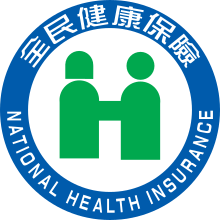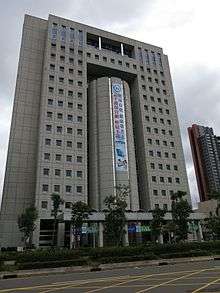Healthcare in Taiwan


Healthcare in Taiwan is administered by the Ministry of Health and Welfare of the Executive Yuan. As with other developed economies, Taiwanese people are well-nourished but face such health problems as chronic obesity and heart disease.[1] In 2002 Taiwan had nearly 1.6 physicians and 5.9 hospital beds per 1,000 population.[1] In 2002, there were a total of 36 hospitals and 2,601 clinics in the country. Per capita health expenditures totaled US$752 in 2000.[1] Health expenditures constituted 5.8 percent of the gross domestic product (GDP) in 2001 (or US$951 in 2009[2]); 64.9 percent of the expenditures were from public funds.[1] Overall life expectancy in 2009 was 78 years.[3]
Recent major health issues include the SARS crisis in 2003, though the island was later declared safe by the World Health Organization (WHO).[1]
The current healthcare system in Taiwan, known as National Health Insurance (NHI, Chinese: 全民健康保險), was instituted in 1995. NHI is a single-payer compulsory social insurance plan which centralizes the disbursement of healthcare funds. The system promises equal access to healthcare for all citizens, and the population coverage had reached 99% by the end of 2004.[4] NHI is mainly financed through premiums, which are based on the payroll tax, and is supplemented with out-of-pocket payments and direct government funding. In the initial stage, fee-for-service predominated for both public and private providers. Most health providers operate in the private sector and form a competitive market on the health delivery side. However, many healthcare providers took advantage of the system by offering unnecessary services to a larger number of patients and then billing the government. In the face of increasing loss and the need for cost containment, NHI changed the payment system from fee-for-service to a global budget, a kind of prospective payment system, in 2002.
Healthcare reform

Taiwan started its health reform in the 1980s after experiencing two decades of economic growth.[5] In 1987, the government did away with the martial law which mobilized the governmental departments. The government set up a planning commission and looked abroad to study other countries’ healthcare systems. Taiwan looked at more than ten countries and combined their best qualities to form their own unique system. In 1995, Taiwan formed the National Health Insurance (NHI) model. In a 2009 interview, Dr. Michael Chen, Vice President and CFO of Taiwan's National Health Insurance Bureau explained that one of the models investigated was the United States and that fundamentally, NHI "is modeled after Medicare [in the USA]. And there are so many similarities – other than that our program covers all of the population, and Medicare covers only the elderly. It seems the way to go to have social insurance."[6][7] NHI delivers universal coverage offered by a government-run insurer. The working population pays premiums split with their employers, others pay a flat rate with government help and the poor or veterans are fully subsidized. Taiwan’s citizens no longer have to worry about going bankrupt due to medical bills.[8]
Under this model, citizens have free range to choose hospitals and physicians without using a gatekeeper and do not have to worry about waiting lists. NHI offers a comprehensive benefit package that covers preventive medical services, prescription drugs, dental services, Chinese medicine, home nurse visits and many more. Working people do not have to worry about losing their jobs or changing jobs because they will not lose their insurance. Since NHI, the previously uninsured have increased their usage of medical services. Most preventive services are free such as annual checkups and maternal and child care. Regular office visits have co-payments as low as US $5 per visit. Co-payments are fixed and unvaried by the person’s income.[9]
| ≈ 1906 | ≈ 1998[10] | ≈ 2012[11][12] | |
|---|---|---|---|
| Life Expectancy | M: 39 years; F: 43 years | M: 72 years; F: 78 years | M: 76 years; F: 83 years |
| Infant Mortality | 84.1 per 1,000 live births | 6.14 per 1,000 live births | 5.10 per 1,000 live births |
| Maternal Mortality | 7.6 per 1,000 live births | 0.9 per 1,000 live births |
By 2001, 97 percent of the population were enrolled in the program. Every enrollee has a Health IC smart card. This credit-card-size card only contains 32 kilobytes of memory that includes provider and patient profiles to identify and reduce insurance fraud, overcharges, duplication of services and tests.[13] The physician puts the card into a reader and the patient’s medical history and prescriptions come up on a computer screen. The insurer is billed the medical bill and it is automatically paid. Taiwan’s single-payer insurer monitors standards, usage and quality of treatment for diagnosis by requiring the providers to submit a full report every 24 hours. This improves quality of treatment and limits physicians from over prescribing medications as well as keeps patients from abusing the system.[8]
Patients and doctors alike are satisfied with NHI . However, doctors have been more dissatisfied because fee premiums are controlled by the system as well as selection of services provided under the system. Also, doctors could be heavily penalized for a wide variety of reasons such as seeing too many patients or offering too many services even if patients and services were valid. Even so, patients' satisfaction has been in the 70 percent range. This system has led to protests by health care providers. At the beginning of 2006, satisfaction decreased to the mid-60 percent range because the program needed more money to cover its services. Since then, satisfaction has gone back to the 70 percent range. Enrollees are satisfied with more equal access to health care, have greater financial risk protection and have equity in health care financing.[8]
Taiwan has the lowest administration cost in the world of 2 percent.[8] Before NHI, Taiwan spent 4.7 to 4.8 percent on health care. A year after NHI, it increased spending to 5.39 percent. Prior to NHI, the average annual rate of increase every year was around 13 percent. Now, the annual rate of increase is around 5 percent.[5] Taiwan spends a little over 6 percent in GDP and less than US $900 per person.[14]
Problems
Even with all their success in their healthcare system, Taiwan has suffered many misfortunes. The government is not taking in enough money to cover the services it provides, so it is borrowing money from banks.[15] The revenue base is capped so it does not keep pace with the increase in national income. Premiums are regulated by politicians[16] and they are afraid to raise premiums because of voters. There is a low doctor-to-population ratio resulting in too many patients depending on too few doctors. Patients visit the doctor more frequently causing doctors to keep visits short to about 2 to 5 minutes per patient.[17] There is no system to regulate systematic reporting of clinical performance, patient outcomes and adverse events, thus leading to a lower quality of care compared to other countries like the U.S. and Canada.
Nursing
Ministry of Health and Welfare in charge of law,regulation in Taiwan, Nursing is a licensed profession in Taiwan(ROC) with specialist education for nurses.
See also
- HIV/AIDS in Taiwan
- Centers for Disease Control (Taiwan)
- Ministry of Health and Welfare (Taiwan)
- National Health Research Institutes
- Health care compared: tabular comparisons of health care in the US, Canada, and other countries not shown above.
- List of hospitals in Taiwan
- Nursing in Taiwan
References
- 1 2 3 4 5 "Taiwan country profile" (PDF). Library of Congress Federal Research Division. March 2005. Retrieved 2008-05-04. This article incorporates text from this source, which is in the public domain.
- ↑ GDP data refer to the year 2009. World Economic Outlook Database-April 2010, International Monetary Fund. Accessed on April 24, 2010.
- ↑ List by the CIA World Factbook (2009 estimates)
- ↑ Fanchiang, Cecilia."New IC health insurance card expected to offer many benefits", Taiwan Journal, January 2nd, 2004 Accessed March 28, 2008
- 1 2 Reid, T.R. (2008). "FRONTLINE: Sick Around the World". Public Broadcasting Service.
- ↑ "Jonathan Cohn interviews Taiwan's Dr. Michael Chen: The Case for Single-Payer Health Care (Transcript)".
- ↑ "TRNtv:Jonathan Cohn interviews Taiwan's Dr. Michael Chen (Video)". Retrieved 11 September 2009.
- 1 2 3 4 "Taiwan Takes Fastrack to Universal Health Care". All Things Considered, NPR. 2008-04-15. Retrieved 2008-10-05.
- ↑ Jui-Fen Rachel Lu; William C. Hsiao (2003). "Does Universal Health Insurance Make Health Care Unaffordable? Lessons From Taiwan". Health Affairs. 22 (3): 77–88. doi:10.1377/hlthaff.22.3.77. PMID 12757274.
- ↑ Source: Lee, Ming-Liang (2001-05-14). Health Care in Taiwan – Past, Present and Future. 54th World Health Assembly.
- ↑ "The World Factbook: Life Expectancy at Birth". The World Factbook. Central Intelligence Agency. Retrieved 20 August 2012.
- ↑ CIA on Infant Mortality (2009)
- ↑ Chen, Yuh-Ning (September 2003). "Taiwan'S Health IC Smart Card Security and Privacy Policy" (PDF). Retrieved 2008-03-16.
- ↑ Ian Williams (2007-10-07). "Taiwan gets healthy". The Guardian.
- ↑ Reid, T.R. (2008-04-15). "Taiwan Takes Fast Track to Universal Health Care". National Public Radio.
- ↑ Lee, Lung-Sheng (1999). "Is the Multi-HMO System a Promising Candidate for National Health Insurance Reform in Taiwan?". B>Quest.
- ↑ Gunde, Richard (2004-09-30). "Healthcare in Taiwan: Successes and Challenges".
External links
| Wikimedia Commons has media related to National Health Insurance. |
- "Taiwan Takes Fast Track to Universal Health Care" by T.R. Reid, All Things Considered, April 15, 2008.
